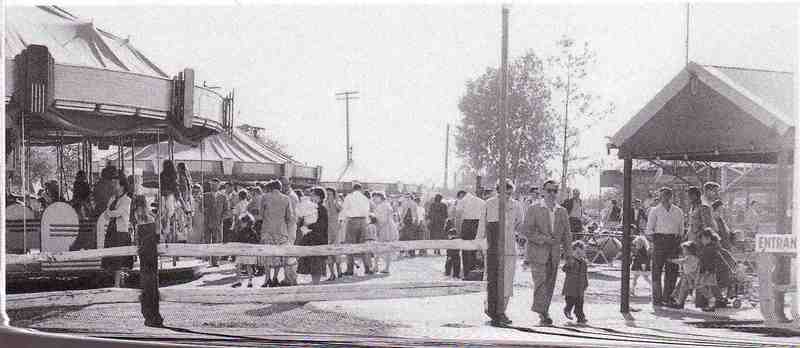
After reading an article on the amusement park industry in Billboard magazine, native Clevelander Stuart Wintner opened the Memphis Kiddie Park on Memphis Avenue in Brooklyn on May 28, 1952. The park was one of several designed and operated by Wintner, including parks in Philadelphia and Columbus. Although this small, family-run attraction seems unique today, the Memphis Kiddie Park once competed with similar child-oriented parks such as the Kiddieland parks in Warrensville Heights and at the Cleveland Zoo as well as with much bigger regional amusement parks such as Geauga Lake and Cedar Point. It has outlasted most of them and provides a nostalgic feeling for the families that bring their children there.
With its location amid postwar suburban tract housing, factories, and shopping plazas, Memphis Kiddie Park, like Wintner’s drive-in theater across the road, was aimed squarely at the children of working- and middle-class families. Easily accessible by car, the small roadside park was a natural draw, but it sweetened the deal by offering free parking. In this way, the park was both different from earlier amusement parks that touted their separation from urban life, including places like Puritas Springs, Euclid Beach, Geauga Lake, and Cedar Point, which shared with resorts a tendency to near springs or shorelines.
However, Memphis Kiddie Park was typical in its appeal to mass society. Just as older parks often lay at the end of trolley lines or along interurban lines and thus provided a different but comparably inexpensive form of access, it took advantage of suburban highways, anticipating many other suburban amusement and theme parks, most famously Disneyland. Like the earliest amusement parks on famous Coney Island, Memphis Kiddie Park and similar children’s amusement parks nationwide also charged no entrance gate fee. Guests could buy a roll of tickets to use for rides, paying only for each individual ride. Another way that Memphis Kiddie Park was typical in its early years was that it featured rides that were mass-produced and present at many other kiddie parks. In fact, the Allan Herschell Company, a ride maker based in Buffalo, New York, since the 1910s, not only made Memphis Kiddie Park’s rides but also similar or identical ones that once excited children in hundreds of locations nationally. Memphis Kiddie Park originally opened with nine Herschel-produced rides, which included the Train, Merry-Go-Round, Airplanes, Hand Cars, Boats, Kiddie Ferris Wheel, Jeeps, Skyfighters, and the Little Dipper. All were staples of kiddie parks across the country.
The Little Dipper is the most popular ride in Memphis Kiddie Park and serves a significant role in roller coaster history. It is significant because it is the oldest operating steel roller coaster in the country and helped usher in a new era of steel roller coasters that continues today. The roller coaster has one three-car train and seats two across with two rows per car, giving the coaster a capacity of twelve riders. The Little Dipper was one of the first roller coasters to operate on the chain lift system, which is now the most common system used for roller coasters today. The Little Dipper only became unique because most of the dozens of parks that also featured the ride closed decades ago, with the Little Dipper at western Pennsylvania’s Conneaut Lake Park standing as a rare exception.
Like drive-in theaters, kiddie parks recaptured a lost novelty only when they outlasted the demise of the heyday of their popularity as national phenomena. This happened as a result of the increasing competition for families’ leisure time brought by shopping malls, theme parks, television, and video game systems. Across the region and the nation, kiddie parks began to close and many owners lost interest in saving their parks and began selling their land. Memphis Kiddie Park now seems unique because its serves as a historic relic of the peak of amusement parks. The park has been able to sustain success because it still provides convenient, affordable fun in a location that is convenient for Clevelanders – and perhaps most importantly, it has achieved uniqueness through its persistence, establishing itself as a local landmark. Several generations of Clevelanders have gone to the Memphis Kiddie Park, and new families continue to plan on bringing their kids to the park one day for some good old-fashioned summer fun.
Images





